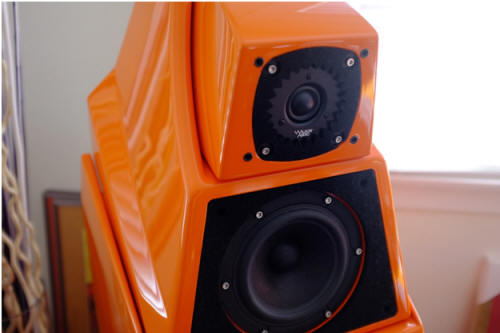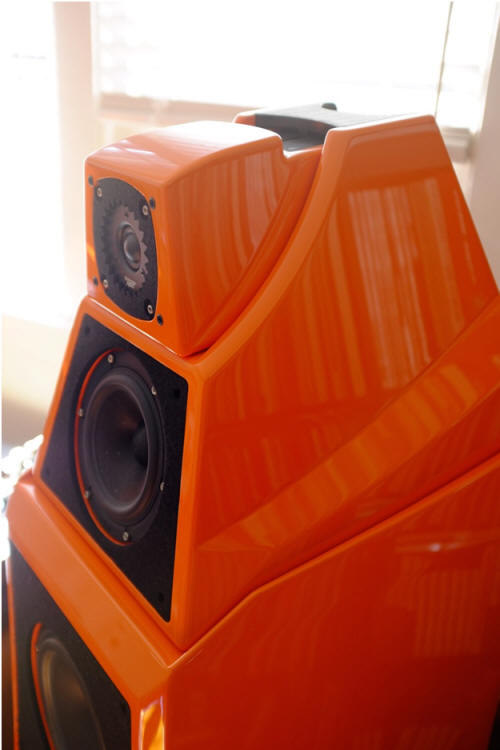|
|
You are reading the older HTML site
Positive
Feedback ISSUE 76
wilson audio Alexia Loudspeakers as reviewed by Danny Kaey
Alexia. Everyone wants to know Alexia. Everyone wants to have Alexia. She's the femme fatale who has you wrapped up in dreams of being James Bond on a super secret mission to save the world. She's the supercar that turns on a dime, that lurches forward with every step on the gas pedal; she jumps to life the moment you press the ominous "Engine Start" button, red, preferably, letting you hear the thunder as she fires up her V12 engine (sans modern day green BS "turbo charging"). Alexia is Riva's Domino coupé yacht, sleek, sexy, nay, hot, parked in your dock, ready to go on a quick trip to really anywhere in style, class and elegance second to none. In short, Alexia is a necessity we all dream of, yearn for and want. When I cued up Jungle's The Heat on the Brinkmann / 4P / The Pickup combo the other day, thunderstorm and lighting struck my room. Easily peaking at 105+ db— for those of you in Rio Linda, that's like loud—I felt bass energy that shook my bottoms; I felt air pressure around my ears pulsating to the rhythm of the bass line. You should give it a try. Assuming Jungle has heard Alexia, I'd wager they picked the name "The Heat" to compliment the scrumptious, deliciously devilish beats that, well, turn the heat up in your panties. Flat down to 23Hz in my room (results may vary of course), Alexia will turn any captured sound into music that you can almost touch and definitely feel. Volume baby, volume. Wilson Audio of course, is no stranger to audiophilia. Heck, Wilson Audio (Specialties) is perhaps one of the few—the only?—mainstream high-end audio company that has managed to cross over into the real world unlike any other speaker manufacturer has been able to. Since my days of buddying up with Josh Ray and our SonicFlare venture, Wilson Audio embodied what we wanted to create with SonicFlare: equate high-end audio with high-end, exotic sports cars with the benefit of having them perform pole setting lap after lap in your room. I'll even go further and say that no sane speaker manufacturer wouldn't want to be like Wilson Audio. No, really. You see, when you get to the level of being able to have your stuff shown and photographed in the world's fanciest of homes (and yachts!), you have succeeded in "it". You have made "it". "It" of course being the recognition that you are someone, somebody. Two bit schlubs clearly wouldn't cut "it". "It" refers to being recognized not only by your peers—i.e.. audiophiles—but also those outside the peripheral vision; people who enjoy a certain quality of life, fine cars, fine wine, fine music, you get my point. An often played to death—I try to keep it to a few times a year so as to not induce listener fatigue—audiophile album is of course Belafonte at Carnegie Hall. The ironic capture of a die-hard communist performing in a music hall built to express musical freedom (and freedom in general) is often lauded as being the quintessential live recording to ever have existed. So magnificent is the recording that even as Classic Records had reissued this record time and again in various incarnations, Chad Kassem of AcousticSounds felt that he could do it better still. And deliver on that premise he did. In spades. First of all, you notice the absolute immensity of the soundstage literally enveloping you; no, it's quite eerie really. Stretching beyond my own four walls, I quickly realized how a definitive piece of music history had been captured so transparently, so expertly, so divinely that in shear terms of "demo" quality, there aren't that many other albums that compare. The orchestral arrangement is stunning; and, once Belafonte begins to sing in his svelte, soulful, debonair voice, it's like game over. The sheer image density and specificity Alexia manages to portray is simply stunning. There's body, there's weight, but more than that, you feel drawn into the performance unlike anything else you have ever heard. A few years ago Dave Wilson started a video series on YouTube, describing various ideas, memoirs, and thoughts; really, it was his way of keeping Wilson Audio followers up to date with iconic, unique behind the scenes information and trivia on various subjects. Dave clearly has the gift of being able to connect the dots for your typical non-audiophile: educating you on what's important, why he's done what he's done and how it all just makes sense in the real world. One such YouTube clip—a few years old now—describes the development of Alexia from inception to concept to reality; visually you are reminded at each step of the way that literally every inch of the cabinet is purpose built: even seemingly minute and at first not necessarily related elements of the design are carefully scrutinized to produce the best possible outcome. Then, at one point through the video presentation, Dave Wilson proclaims what is perhaps the fundamental difference between Wilson Audio and most other loudspeaker manufacturers: "the ultimate goal at WA is to not build a speaker that obediently follows a frequency response profile; we want it to sound like real music".
A recent treasure find via my trusted source for all things vinyl, is Nina Simone's very first—and very incredible—album, Little Girl Blue. Released in 57' on the Bethlehem label, her sultry ballad voice shines with sparkle, sensuality and oozes with classy, groovy-jazzy tunes. Having heard some of the tracks many times on questionable reissues, digital releases and other such means of delivery, I felt stumped when first I played this NM copy via the Alexia / Brinkmann / EINSTEIN system. Permit me to explain: typically, I hear a loudspeaker do one of two things; project an image behind the speaker or in front of the speaker. Rarely, if ever, do I hear a speaker lose its defined space in your room and project an image with an effect perhaps best described as holographic; meaning that the image appears completely devoid of any speaker boundary, instead, appears to literally float as a projected image in front of you. Think IMAX 3D Gravity movie. Think Lawrence of Serbia, nay, Arabia, in the recently remastered from 70mm prints Blu-ray. Think positively stunning. That is precisely what I heard when I played this Nina Simone record, in particular, the title cut, Little Girl Blue. Her voice quite literally floating in an imaginary space in front of me; lifelike and life sized. Wow. Now my history with Wilson Audio is an interesting one. I first got wind of WA as a cover shot on one of my favorite German review magazines (who's editor in chief [Dirk Sommer] left a few years ago to launch www.hifistatement.net the other rag I opine for), Image Hi-Fi, ca. 1994. That model was the most often referred to WA classic, the Watt / Puppy 5. Reading the review, I felt as though the reviewer must have had an outer body experience. So powerful and remarkable had he felt the 5 to be that I set myself a bookmark to see and hear this magical speaker myself. Some years later, having relocated to Los Angeles in the mid 90's, I did in fact hear the system 5 speaker at LA Audio and Video (a multistory Angelean mecca for all things high-end audio and video related) and was mightily impressed with what I heard. Then something changed. Being a very young Jedi, my taste buds appeared in constant flux. Consistency was not on my radar—yet. You see, over time, it became clear to me that it wasn't all about neutrality, resolution and all other audiophilia we (well, some of us) so associate with high-end audio. No, in real life, music really has none of those qualities—the trick therefore, is to account for the inherent loss in transfer energy from live to recorded; account for all the typical room issues, yet remain true to what music is all about: body and soul, that thing that draws you in. Somehow, somewhere Dave Wilson must have realized this too and thus began the ongoing quest to produce the real deal: music playback with just enough resolution and neutrality, yet not forgoing body and soul; making it sound real as opposed to sounding like a Memorex facsimile. Not many speakers manage that, yet many claim to do just that.
Cueing up Yello's "Friday Night" off their last album Touch, I heard an absolutely massive soundstage with dramatically powerful pulsating beats to match the overall ambience. Yello have absolutely mastered the art of creating magnificent, opulent and truly immersive sonic landscapes, captured in glorious—ProTools—perfection. Dieter Meier's supremely baritone vocals are eerily realistic and stupendously well proportioned via Alexia. Having specifically requested Nordost's latest Valhalla 2 series of speaker cables and interconnects (power cables) for this review, I was struck by the realism and definition of all the songs contained on Touch. Normally, well, let's call it almost always, WA demos their speakers with Transparent Audio cables—having been previously impressed with Nordost's latest Tyr 2 line up, I wanted to see if what has become the normative, was in fact replicable with other cable alternatives. Alas, EINSTEIN's own The Thunder and The Flash cables worked equally well, as did of course Kubala-Sosna's Emotion line. With each cable swap, different characteristics quickly became apparent—like I said, resolution isn't everything. Nordost's V2 line quickly called for typically clichéd exclamations "listen to this bass! Wow. Killer sound dude. Where did you get these? Da bomb." I know, silly stuff mostly, alas, every oddball reference and joke does have an element of truth, otherwise—well, ya'll know the saying. On a recent visit to the WA factory in Utah, the clarity of Dave Wilson's vision became that much clearer and far better focused. You can't be a top industry leader and measuring stick if you don't have the goods and operations to back up your story. Dave Wilson understood that early on. He had to have, otherwise this factory visit would have been much like many others: we've got these guys over here doing this; those dudes over there are on their lunch break; these peeps down there are just getting finished with whatevertheheckicantrememberit they were working on: no, a visit to the temple of WA is of a different nature all together. The minute you walk in the facility (which WA owns), you notice an exceptional level of operational ninja detail. No such thing as a chance close encounter of the 3rd kind. There is a reason for everything and everything has a cause and effect. For example, the actual factory is setup in circular fashion—Apple space ship campus anyone?—so that there is a very clear and understood way of the world. Each speaker, no matter the final retail cost, starts life exactly, precisely, the same way. At each point of the manufacturing process you can't help but feel my head recanting each and every silly word I had uttered over the years—no wonder that WA requires each and every reviewer to visit the factory prior to a formal review being allowed to proceed. This is it. This is the big boys game. Professionals. Let me say it once more: professionals. Very Apple like is indeed the way WA looks at everything, measures everything. Understands everything. Seeks to improve everything. There are no second guesses, no we-could've-should've-would've-done-it-differently. There is a reason that when you call Jerron, WAs Customer Service Guru, you will always get the same courteous response; why customers who own decades (!) old WA speakers are still able to get their service needs met. As it so happened, a WA customer had just sent in their pair of Watt / Puppy 3s for a complete once-over. "Replace whatever is in need of service, refinish the speakers (wood veneer in this case) and ship'em back." Please tell me which other company listed on the Stereophile's advertiser page that can accomplish this—not many. A precious few. There's that professionalism again. I could go on. Wilson Audio doesn't play games. This is serious business. 45 odd lives employed at the factory depend on Wilson Audio making the right choices each and every day. From engineering and production (Dave and Daryl Wilson, Korbin Vaughn) to sales and marketing (Peter McGrath and John Giolas) WA's leadership team makes calculated, responsible decisions. Cueing up Metallica's San Francisco Symphony Orchestra album—you know the one that's like famous—opened up a world of hurt. First of all, I didn't think much of this album on the CD release—loud, compressed, processed, it simply didn't shine. The vinyl on the other hand is something else entirely. While it's still a heavy metal band— doh—it seems to have gotten a certain groove and far better sonics along the way. A/B-ing the LP vs. the CD was no contest: the vinyl (played back again via the Brinkmann / 4Point / EINSTEIN combo; the CD via my trusted digital reference, Playback Design's MPS-5) proved far superior in every conceivable way: far greater dynamics, larger soundstage, more clearly defined instrument layers. Sonic bliss? Hardly. Better in every conceivable way? Yes. It is perhaps the overall bass output that Alexia is capable of reproducing, which adds that overall sonic picture of grandiose performance: even on said Metallica, you get oodles of definition, proportion and slam that I simply don't hear on many other speakers. Some may shuv too much, some too little; track after track, Alexia's bass seems to be just right sounding. I think it all goes back to Dave's vision of speakers sounding musical first and foremost; personally, I think that all starts and ends with bass output. It has been proven time and again that while bass is the most difficult of frequencies to recreate, it is also perhaps the most rewarding; for it doesn't merely give life to those lower frequencies, no, it also leaves a sonic print on everything else above it. In my room I confirmed a flat response down to 23Hz. Full range baby, full range! Incidentally, whilst Peter McGrath was setting up this pair of Alexias, he brought along a CD Police in Dub by German dub-band Dubxanne. As the name suggests, Dubxanne went through the Police catalog and re-imagined each track as a corresponding dub version. Clever these Germans are, clever, I say. Cueing up Peter's reference track (all others are great as well!), "Roxanne", I sat and stumped in shock-and-awe. Sweet fanny Adams! My, oh my. What prodigious bass line came across the room, instantly smacked my chest like a 200lb mallet. No, seriously. This was legit. Mind you, all the while projecting a three dimensional soundstage, with spot on imaging, and a literal wall-to-wall sound that I never quite heard before. Personally, I dig the WA look. Modern, contemporary and at some point destined to be classic lines, each speaker's cabinet is designed in a way so as to maximize the results. Form follows function. Alexia is a heavy beast. Weighing in somewhere around 256lbs per speaker, I have no doubt that Alexias life-force is a direct result of the speaker's visual and engineering vehemence. Each panel cut from a super-secret phenolic resin compound, is bonded together by glue that some NASA genius discovered and now Wilson Audio utilizes. It is said that this glue bond is so immensely strong that you would break the resin compound before the glue would give even a fraction of a micron. Fit and finish is automotive like. No. It is better than automotive. A friend of mine who concerns himself daily with the mastery that is automotive detailing, couldn't believe his eyes when he saw the Classic Orange finish of my pair. "Dude. This is like Bugatti Veyron quality" "Do you know why I know that", he asked. "Because I just refinished one last week for my client who owns 7." I mean seriously, what are you even supposed to say to that. Communists and those seeking to redistribute wealth be damned. Trickle down works. Wilson Audio and her 45 employees all making a real living wage is proof positive, who else can afford $52k loudspeakers? Mind you, that's for a pair of let's just call them "Alexias". A pair of XLFs will set you back $210k; the just announced (@ Denver's Rocky Mountain Audiofest 2014) and all new Sabrina will set you back whatever the price will be when it's officially announced, though it will be a great opportunity to own WA at a new, lower price point. That's quite the spread. As I mentioned earlier, to Wilson there is no manufactured qualitative difference: Sabrina is built to the same exacting standards as a pair of XLFs—peace of mind for the dealer, the customer and WA. Having heard Alexia, I'd be instantly smitten to hearing Sabrina. Sign me up boys! Consuming and understanding the sound once, you become addicted to more. Satisfaction guaranteed—otherwise known as the Wilson Effect. I call it smart. The Wilson Audio sonic signature is coherent across the entire range of products. Beacon's track "Pulse" off their first album The Ways We Separate, is all about rhythmically pulsating bass lines, cleverly produced sound-space fill and perfectly meshed R&B soul. The song's atmosphere is deceptively simplistic, yet Alexia manages to create an entirely submersive and spacious experience from the ingredients. Here again you hear Alexia's stupendously amazing bass output; Alexia's complete disappearing act and imaging prowess and there's that incredible 70mm IMAX like soundstage size (again). I urge you to get this album, if for no other reason than to hear what I hear. Alexia then is something special. Unquestionably, Wilson Audio has created a future classic. My guess is that in time, Alexia will go down in history along side Watt / Puppy (Sasha) to leave a permanent mark on the entire market that is high-end audio. In many ways, Alexia is a measuring stick—not only for ultimate sonic retrieval, but set at the price point of $52k a yardstick of dollars and sense: how much can—should—a reference level loudspeaker cost? When you factor in all that is Wilson Audio, Alexia's price seems to reflect not an arbitrary number set by mystics in the accounting room; rather, a real-world price built around sound principals in engineering and manufacturing excellence. That ain't cheap. Never has been. Never will be—if anything, there's clear indications that this level of mastery will only get more expensive in time—these are after all, real products, made in a real economy and not built around Wall Street hype—cloak and dagger—thus, strike while the iron is hot, the dollar in your pocket galloping and mama bear out shopping: this type of a deal is rare; rarer still is the fact that most likely, barring the unforeseen, Wilson Audio will still be here in 40 years time. Which would make it their 80th anniversary. That's brilliance. That's Wilson Audio. A+++++ Danny Kaey
Alexia Loudspeakers
Wilson Audio Specialties |












